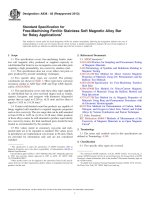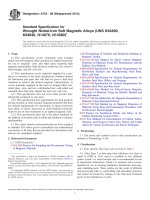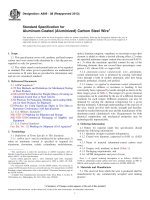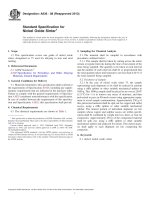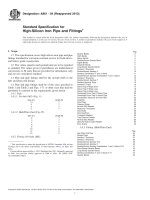Astm a 938 07 (2013)
Bạn đang xem bản rút gọn của tài liệu. Xem và tải ngay bản đầy đủ của tài liệu tại đây (67.91 KB, 3 trang )
Designation: A938 − 07 (Reapproved 2013)
Standard Test Method for
Torsion Testing of Wire1
This standard is issued under the fixed designation A938; the number immediately following the designation indicates the year of
original adoption or, in the case of revision, the year of last revision. A number in parentheses indicates the year of last reapproval. A
superscript epsilon (´) indicates an editorial change since the last revision or reapproval.
clamping head shall be equipped with a device capable of
applying the necessary tensile load.
5.1.3 The clamping heads shall clamp the wire firmly, but
should not damage it to the extent that fracture occurs at the
clamping point during twisting. The distance between the
clamps is the test length. The wire shall be twisted only along
the test length, and not at the point of clamping. These
requirements can be satisfied by bending a short section at each
end of the specimen to an angle of about 90° to the wire axis,
as described in 6.3.
1. Scope*
1.1 This test method describes the torsion (or twist) testing
of metallic wire.
1.2 The values stated in U.S. customary units are to be
regarded as the standard. The SI equivalents of U.S. customary
units may be approximate.
1.3 This standard does not purport to address all of the
safety concerns, if any, associated with its use. It is the
responsibility of the user of this standard to establish appropriate safety and health practices and determine the applicability of regulatory limitations prior to use.
5.2 Revolution Counter—A mechanism to count the number
of twists shall be provided.
5.3 Protective Shield—A protective shield shall be provided
to protect the operator from flying fragments in cases when the
wire breaks into more than two pieces.
2. Referenced Documents
2
2.1 ASTM Standards:
E6 Terminology Relating to Methods of Mechanical Testing
3. Terminology
6. Specimen Preparation
3.1 Definitions—The definitions related to torsion testing
appearing in Terminology E6 shall be considered as applying
to the terms used in this test method.
6.1 Straightening—The test piece, consisting of a length of
wire, should be straight before being tested. If straightening is
necessary, it shall, unless otherwise specified, be done by hand.
Other straightening techniques are permitted provided surface
damage is avoided. Since the shear stress is maximum at the
surface of the wire during testing, even slight surface damage
such as pits or scratches can cause early fracture, and the
results may not be indicative of the full capability of the wire.
4. Significance and Use
4.1 The complex stress and strain conditions that occur in
the sample during the torsion test are sensitive to minor
variations in materials, making the torsion test a useful tool in
assessing wire ductility under torsional loading.
NOTE 1—During straightening, it is important that the properties and
cross section remain unchanged as far as possible. In particular, the
specimen shall not be subjected to any twisting.
5. Apparatus
6.2 Test Length:
6.2.1 Recommended test length is 8 in. (203 mm) (distance
between the clamping heads). Sufficient material must also be
provided to allow for gripping.
6.2.2 Other test lengths may be used as agreed upon
between the producer and purchaser or as specified in the
appropriate product specification.
6.2.3 When a test length other than 8 in. (203 mm) is used,
the minimum torsions shall be revised in direct proportion to
the change in the jaw spacing, or as determined by the
following formula:
5.1 Clamping Heads:
5.1.1 The torsion test apparatus must have clamping heads
that will remain coaxial (within 10°) during the test.
5.1.2 One clamping head shall be easily displaceable in the
direction of the wire axis. This longitudinally displaceable
1
This test method is under the jurisdiction of ASTM Committee A01 on Steel,
Stainless Steel and Related Alloysand is the direct responsibility of A01.03 on Steel
Rod and Wire.
Current edition approved April 1, 2013. Published April 2013. Originally
approved in 1975. Last previous edition approved in 2007 as A938 – 07. DOI:
10.1520/A0938-07R13.
2
For referenced ASTM standards, visit the ASTM website, www.astm.org, or
contact ASTM Customer Service at For Annual Book of ASTM
Standards volume information, refer to the standard’s Document Summary page on
the ASTM website.
Tx 5
where:
*A Summary of Changes section appears at the end of this standard
Copyright © ASTM International, 100 Barr Harbor Drive, PO Box C700, West Conshohocken, PA 19428-2959. United States
Copyright by ASTM Int'l (all rights reserved);
1
~ T L! ~ L x!
~ L L!
(1)
A938 − 07 (2013)
Tx
TL
Lx
LL
=
=
=
=
position of fracture, defined as complete separation of the
broken ends. If the number of turns does not satisfy the
requirements of the specification, and the initial fracture,
defined as complete separation of the broken ends, location is
within two times the wire diameter from the clamps, the test is
considered invalid and shall be repeated.
minimum torsions for new length,
minimum torsions for 8 in. (203 mm) length,
new length, and
8 in. (203 mm).
6.3 End Preparation—To prevent the gripped ends from
slipping tangentially in the clamps, a minimum of 1⁄2 in. (12.7
mm) of each end of the wire is often bent approximately 90° to
the axis of the test sample. The end sections need not be exactly
parallel to each other. See Fig. 1.
NOTE 2—Specimens often break into more than two pieces, subsequent
fractures resulting from the rapid untwisting of the wire following the
initial fracture. In many cases, the initial fracture will have a smooth
surface perpendicular to the wire axis. The above validity test applies only
to the location of this initial break.
7. Procedure
8. Report
7.1 Tensile Force—Clamp the specimen in the clamps of the
test apparatus with its longitudinal axis coaxial with the
clamping heads and in such a manner that the specimen
remains as straight as possible during testing (see 5.1.1).
Unless specified otherwise, this can be accomplished by
applying a small tensile force to the specimen. This force
should be just sufficient to prevent the specimen from deflecting away from the axis of rotation during twisting. Recommended tensile forces are shown in Table 1.
8.1 The following information shall be included in the test
report:
8.1.1 Specimen identification,
8.1.2 Wire diameter,
8.1.3 Test length, and
8.1.4 Total turns to fracture.
NOTE 3—If a minimum number of turns is specified and this number is
exceeded, the test need not be continued to fracture. It is then sufficient to
record that no fracture occurred.
7.2 Speed of Twisting—The speed of testing should be such
that the wire is not heated appreciably during the test since
excessive speed results in a lowering of torsion values.
Recommended maximum speeds are shown in Table 2.
9. Precision and Bias
9.1 Precision—Sufficient multilaboratory tests have not
been compared to establish the reproducibility of this test
method. Test variables that affect precision include: (1) initial
length and straightness of the wire, (2) the amount of tensile
stress, (3) the speed of testing, and (4) location of the fracture.
7.3 Number of Turns:
7.3.1 After placing the test specimen in the machine, rotate
one clamp at a reasonably constant speed until the test
specimen fractures, defined as a complete separation of the
broken ends.
7.3.2 If the number of turns is satisfactory, the test specimen
is considered as having passed the test, regardless of the
9.2 Bias—Determination of the bias of a test method requires reference standard values for one or more materials
based on many measurements. Such standard reference values
are not available for this test method. Therefore, the bias of the
method is not known.
10. Keywords
10.1 coaxial clamping; fracture; revolution counter; test
length; torsion; torsion testing; twisting rates; wire; wire axis;
wire ductility
FIG. 1 Sketch Showing 90° Bends at Ends of Wire Twist Test
Specimen
Copyright by ASTM Int'l (all rights reserved);
2
A938 − 07 (2013)
TABLE 1 Applied Load for Torsion Testing
Applied LoadA
Diameter of Wire
Pounds Force (lbf)
Inches
Over
Over
Over
Over
Over
Over
Over
Over
Over
Over
Over
Over
Over
Over
Over
Over
Over
Over
Over
Over
Over
Over
Over
Over
Over
A
Up to 0.010
0.010 to 0.015
0.015 to 0.020
0.020 to 0.030
0.030 to 0.040
0.040 to 0.050
0.050 to 0.060
0.060 to 0.070
0.070 to 0.080
0.080 to 0.090
0.090 to 0.100
0.100 to 0.110
0.110 to 0.120
0.120 to 0.130
0.130 to 0.140
0.140 to 0.150
0.150 to 0.160
0.160 to 0.170
0.170 to 0.180
0.180 to 0.190
0.190 to 0.200
0.200 to 0.210
0.210 to 0.220
0.220 to 0.230
0.230 to 0.240
0.240 to 0.250
mm
Over
Over
Over
Over
Over
Over
Over
Over
Over
Over
Over
Over
Over
Over
Over
Over
Over
Over
Over
Over
Over
Over
Over
Over
Over
Newtons (N)
Minimum
Maximum
Minimum
Maximum
0.50
1.0
1.5
2.0
3.0
4.0
5.0
6.0
7.0
8.0
9.0
10
11
12
13
14
15
16
17
18
19
20
21
22
23
24
2.0
4.0
6.0
8.0
12
16
20
24
28
32
36
40
44
48
52
56
60
64
68
72
76
80
84
88
92
96
2.2
4.4
6.7
8.9
13
18
22
27
31
36
40
44
49
53
58
62
67
71
76
80
85
89
93
98
102
107
8.9
18
27
36
53
71
89
107
125
142
160
178
196
214
231
249
267
285
302
320
338
356
374
391
409
427
Up to 0.25
0.25 to 0.41
0.41 to 0.51
0.51 to 0.76
0.76 to 1.02
1.02 to 1.28
1.28 to 1.53
1.53 to 1.79
1.79 to 2.04
2.04 to 2.30
2.30 to 2.55
2.55 to 2.80
2.80 to 3.06
3.06 to 3.31
3.31 to 3.57
3.57 to 3.82
3.82 to 4.07
4.07 to 4.33
4.33 to 4.58
4.58 to 4.84
4.84 to 5.09
5.09 to 5.34
5.34 to 5.60
5.60 to 5.85
5.85 to 6.10
6.10 to 6.35
For sizes larger than 0.250 in. (6.35mm), the tensile force of 1 % of the nominal maximum load of the wire is recommended.
TABLE 2 Recommended Maximum Twisting Speeds
Wire Diameter, in. (mm)
Twisting Speed (Rpm)
<0.040 (1.02)
0.040 to <0.142 (1.02 to <3.61)
0.142 and larger (3.61 and larger)
90
60
30
SUMMARY OF CHANGES
Committee A01 has identified the location of selected changes to this standard since the last issue, A938 – 04,
that may impact the use of this standard. (Approved Sept. 1, 2007.)
(1) Revised Table 1 to show minimum and maximum load
values and wire sizes larger than 0.160 inches (4.06mm) in.
diameter.
ASTM International takes no position respecting the validity of any patent rights asserted in connection with any item mentioned
in this standard. Users of this standard are expressly advised that determination of the validity of any such patent rights, and the risk
of infringement of such rights, are entirely their own responsibility.
This standard is subject to revision at any time by the responsible technical committee and must be reviewed every five years and
if not revised, either reapproved or withdrawn. Your comments are invited either for revision of this standard or for additional standards
and should be addressed to ASTM International Headquarters. Your comments will receive careful consideration at a meeting of the
responsible technical committee, which you may attend. If you feel that your comments have not received a fair hearing you should
make your views known to the ASTM Committee on Standards, at the address shown below.
This standard is copyrighted by ASTM International, 100 Barr Harbor Drive, PO Box C700, West Conshohocken, PA 19428-2959,
United States. Individual reprints (single or multiple copies) of this standard may be obtained by contacting ASTM at the above
address or at 610-832-9585 (phone), 610-832-9555 (fax), or (e-mail); or through the ASTM website
(www.astm.org). Permission rights to photocopy the standard may also be secured from the Copyright Clearance Center, 222
Rosewood Drive, Danvers, MA 01923, Tel: (978) 646-2600; />
Copyright by ASTM Int'l (all rights reserved);
3





